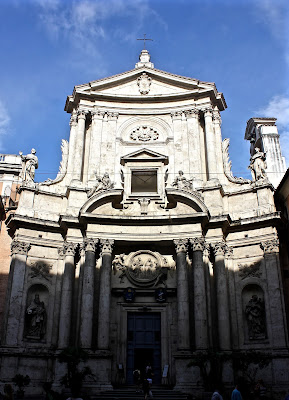Santa Croce in Gerusalemme: the Roman Jerusalem.
The Basilica of Santa Croce in Gerusalemme, not too far from the first Cathedral of the world, Saint John Lateran, is one of the seven pilgrim churches of Rome, according to St. Philip Neri’s tradition. It was built in the 4th century on the site of the ancient palace of Saint Helena, the mother of Emperor Constantine. At the time, churches were built on the tomb of martyrs - this was an important exception as this was the titulus crucis - built to honour and conserve the relic of the True Cross found by the saint in the Holy Land in 325. The titulus crucis consists in a wooden tab that would be from the actual cross. It is probably the tab with the famous INRI acronym (Iēsūs/Iēsus Nazarēnus, Rēx Iūdaeōrum) written in a 1st century font in Hebrew, Greek and Latin.
Land from the Calvary was also placed underneath the foundation of the Basilica and in the Middle Ages the church became known simply as Hierusalem and it refers to this, visiting the church in popular devotion was like entering the Holy City of Jerusalem.
The story of the finding of the True Cross is found in the “Golden Legend” (together for example with the legend of St. George and the Dragon) by the Dominican Friar Jacopo da Varazze. An extremely popular text during the late Middle Ages and Renaissance and in fact, this very story became the subject of a large apsidal fresco commissioned in the 15th century to Antoniazzo Romano, the only Roman Renaissance artist.
The fresco occupies the entire apse of the basilica, in the fashion of the Medieval mosaics found in the same city. The background is decorated in the Renaissance style, it is imagined as a magical landscape with woods, hills, trees, castles but it actually represents Jerusalem: the heavenly city.
It develops itself in a chronological order, from left to right: it begins with Helen in Jerusalem who is inquiring with a Jew where the relics of the cross are - his name is Juda and he will later become the Bishop of Jerusalem. He seems to be hesitant but in the end he reveals where it is: under the temple of Venus on the Golgotha and where Constantine planned to edify the Basilica of the Holy Sepulchre.
The fresco proceeds with the excavation scene, and the crosses are found, but another problem arises: how would they know which one is the real cross? In that moment, a funeral procession is passing by and (quite oddly) they let the corpse lie on each cross to prove which one is real: when they place the body on the third one it miraculously resuscitates. In the third scene we see a dead, naked person sat on a cross.
In the following scene, the central one, is the perfect altarpiece to the whole apse: Saint Helen is holding the Cross, gloriously empty as a sign of glory not of pain. On her side is the Cardinal Pedro Gonzalez de Mendoza, archbishop of Toledo, who commissioned the work when he was titular of the basilica between 1478 and 1495 - he also paid for its restoration in 1500 for the jubilee.
The legend continues with Helen dividing the Cross in three parts: she left one in Jerusalem, she sent the second to Constantinople to his son and the third she brought with her to Rome. The last part of the fresco tells the story of that part of the Cross left in Jerusalem. In 614 it was stolen by the Emperor of Persia but in 627, Heraclius, the Byzantine Emperor finally rescues it.
In the fresco we can see two military formations, at the two sides of a bridge: Heraclius triumphs and he is seen gloriously holding the cross on top of his horse to flight to Jerusalem and bring the cross back. On a little cloud, on the upper right side, appears an angel that warns the emperor not to enter Jerusalem in glory, but in a humble way, just like Our Saviour did. In the last scene, Heraclius enters Jerusalem meekly with the Cross on his shoulder.
The whole scene is crowned by a majestic Christ in the act of blessing, surrounded by two giant, mandorlas with cherubs, on the two sides of this scene, are two clouds with adoring angels.
Unfortunately, this great work of Renaissance art is not as famous as it should be, just like the following one.
This church also hosts another work that recalls the Medieval mosaics scattered through the city. Behind the apse, is the so-called chapel of Saint Helena and in the anti-chapel of it is located a replacement of a 5th century mosaic that collapsed sometimes during the Middle Ages.
It was recreated in a Renaissance style by the pictor papalis Melozzo da Forlì, who already worked with Antoniazzo Romano, for example in SS. Apostoli.
it represents Christ in the act of blessing sorrounded by the evangelists and in the smallest niches are again the stories of the “Invention of the True Cross”. The decoration and the framing of the work is an interesting retake on the same Byzantine and early Medieval works in this same city.









